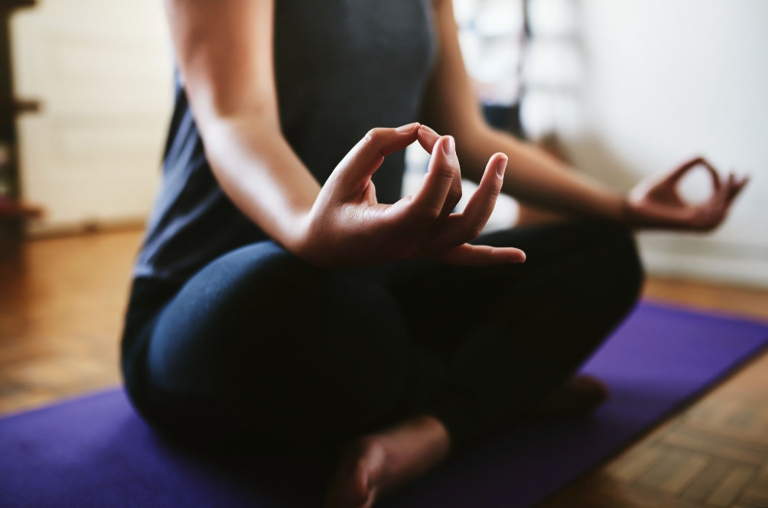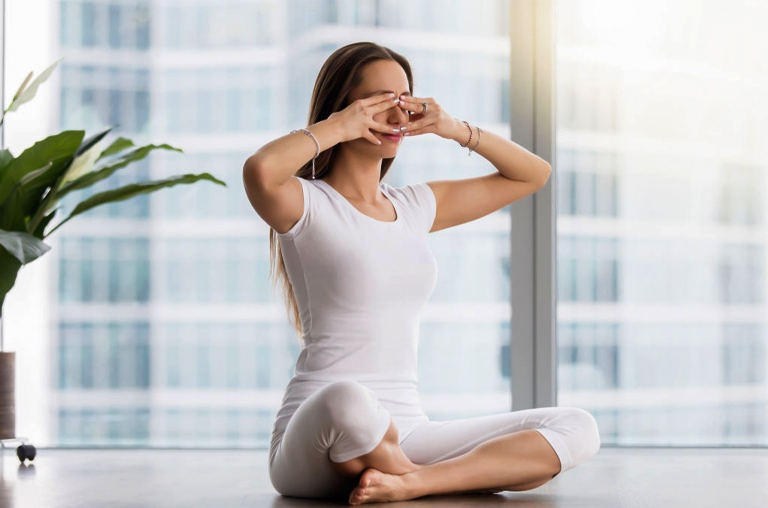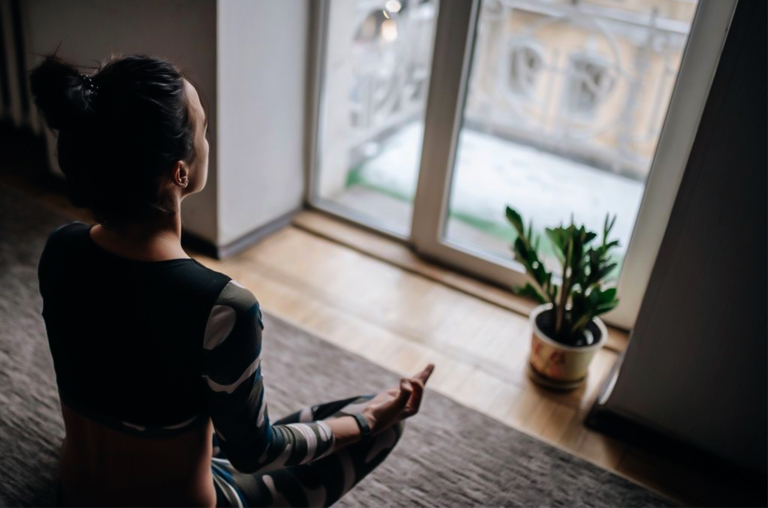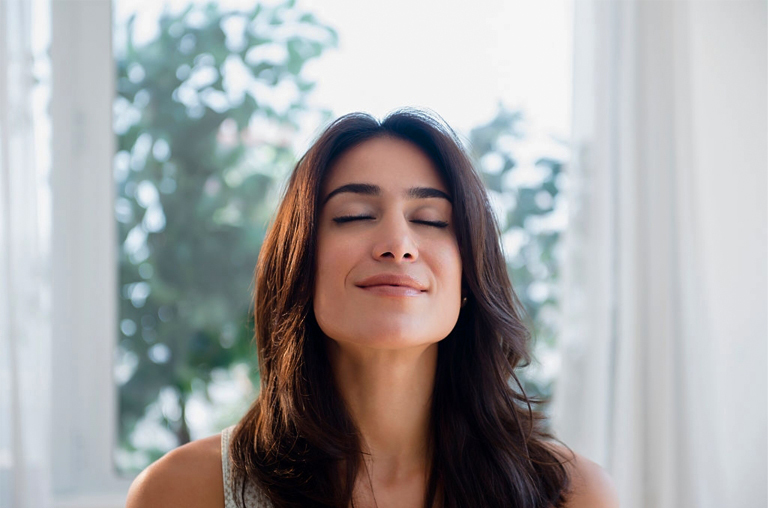Pranayama Benefits: Survival Mechanism You Never Knew!
We all breathe. Yet mindful breathing is a whole different ball game. Modern world is rediscovering the power of the breath with Pranayama.
On Mar 27, 2023 – 14 minutes read

With the growing popularity of yoga around the world, ‘pranayama’ is hardly an unfamiliar word anymore. But just in case you were living under a rock, here’s a quick rundown. Pranayama is an ancient technique in yoga that involves the breath. Yet science says pranayama benefits are so varied and holistic. Its rediscovery is more relevant in the modern world than ever before.
Pranayama is the process of controlling the breath. The conscious awareness and managing the rhythms of the life force both energize and relax the body. It can help one achieve a healthy body and mind.
Pranayama Benefits: Tap Into The Power Of Your Breath!
With extensive attention on mental health around the world, people are becoming aware of the constant need for mental health care— which the world had side kicked as taboo until recently. As it turns out, meditation plays a vital role in improving one’s mental health. Meditation is a part of yoga that deals with mental relaxation and concentration with complete attention to thoughts and breath.

One such incredibly effective yoga technique is pranayama, with a distinctive breathing exercise on its own. Pranayama is the fourth of Patanjali’s eight limbs of yoga. Scientific research suggests that mindful breathing is one of the most effective ways to lower one’s stress level and improve various health factors. Here, with this particular technique, you can learn how to tap into your life force to reap the several benefits it offers.
But, What Exactly Is Pranayama?
Before we get into the pranayama benefits you can acquire, let’s see what exactly is pranayama. Pranayama, by definition, means the conscious awareness and control or extension of the life force — breath.
Pranayama is a combination of two words; Prana — energy source or life force (breath sustaining the body) and Ayama — to control or extend. Together, the two means breath extension or controlling breath on purpose. To be more precise, it is the practice of breathing exercises and patterns by paying attention to your breathing. It involves learning how to manipulate the breath smartly.

You purposely inhale, exhale, and hold your breath in a specific sequence while controlling the time, duration, and frequency of every breath you hold. The ultimate goal is to connect your mind and body for healing, and well-being, and to attain higher states of awareness. According to yoga, the breath carries a person’s life force and all of its techniques focus on the life force. Roger Cole, an Iyengar (1) Yoga teacher, and physiology researcher speaks highly of this breathing exercise:
“Pranayama is at once a physical-health practice, mental-health practice, and meditation. It is not just breath training; it’s the mind training that uses the breath as a vehicle, and it makes your entire life better.”
Why Pranayama? Pranayama Benefits
However, not everyone can stomach how a simple breathing technique can promise such diverse benefits. Because our body breathes on autopilot — on its own, then why is there a need to familiarize oneself with conscious inhaling and exhaling? Well, according to Sat Bir Singh Khalsa, assistant professor of medicine at Harvard Medical School who studies yoga and meditation, “There is a very direct relationship between breath rate, mood state, and autonomic nervous system state.”
Heart Rate, Mood And Autonomic Nervous System
The autonomic nervous system dominates the body’s parasympathetic (rest and restore) and sympathetic (fight or flight) systems. In addition, when there are potential threats, it can dial functions like respiration, heart rate, and digestion up and down as necessary in response.
Unfortunately, the world we live in right now is giving every single person completely different episodes of anxiety with the constant bombardment of social media, emails, news, and whatnot. Our breath changes in response to emotions. For instance, when you get mad or anxious, your breath starts to come out shallow and rapid. Hence, you have to be aware of how emotions affect your mental health and how you can take care of the adverse effects.
Sympathetic And Parasympathetic Nervous Systems
For starters, research shows with every breath you take, millions of sensory receptors in your respiratory system send signals via the ‘vagus nerve'(2) to your brain stem. When your heart starts to beat faster, it triggers your brain to activate the sympathetic nervous system (fight or flight). This turns up stress hormones, anxiety, muscle tension, blood pressure, heart rate, and sweat production.
On the flip side, when you slow down your breath, your brain activates the parasympathetic response system (rest and restore) dialing down everything mentioned earlier to bring relaxation, calmness, and mental clarity. It is proved through a number of studies that actively changing the breath rate can change the autonomic function and mood states that different emotions bring as well. Now, here comes the benefits of pranayama in the picture.
Pranayama Benefits From Mood To Metabolism
Pranayama is used with other practices like asanas (physical postures) and dhyana (meditation). These together help you bag the many benefits of yoga. However, pranayama has benefits of its own such as spiritual, physical, psychological, and therapeutic effects. It calms your nervous system and energizes your nervous system. Let’s see what benefits of pranayama you have been missing out on!
Gives You Emotional Stability
As you are already aware, manipulating your breath smartly can alter how you feel. Studies show that you can bring 40 percent variance in feelings of fear, anger, joy, and sadness by changing breathing sequences. In a 2013 study(3), pranayama proved to calm the nervous system. This improved stress response and reduced stress levels in healthy young adults.

Another study proved that practicing pranayama significantly decreased episodes of anxiety before taking a test. This effect was linked to the increased uptake of oxygen. Pranayama has proved to relieve symptoms of chronic stress and mood imbalances. It reduces depression, stress, negative feelings, PTSD symptoms, and anxiety symptoms. Becoming aware of your breath helps in creating stress resilience. Simply becoming aware of each breath tends to slow it down, especially when you are mad or anxious.
Pranayama Benefits: Help With Weight Loss
The breathing practice of pranayama is believed to increase the levels of leptin. Leptin is a hormone produced by fat tissue that signals the brain to hinder hunger. Moreover, when you modify the breathing sequence and focus on certain parts of the body, energy is released. It leads to increased sweating, which in turn burns calories and fat.

A type of pranayama named ‘kapalbhati pranayama’ focuses on the abdominal part which activates the abdominal muscles resulting in fat reduction. Studies showed that there was a significant decrease in the Body Mass Index (BMI) and waist-hip ratio through this practice.
Helps Improve Digestive System
The human body is said to have two brains; in the head and the gut. By stimulating brain activity, pranayama can monitor and improve the digestive system as well. It activates your diaphragm, which is the dome-shaped muscle under your lungs and above your digestive and internal organs. This act of pranayama breathing causes the diaphragm to rise and fall while gently massaging other organs, which improves the digestive system.

Diseases caused by anxiety and stress like diarrhea and hyperacidity can be treated by this particular breathing technique as it calms your mind and relieves anxiety. Nowadays, Irritable Bowel Syndrome (IBS) and Inflammatory Bowel Disease (IBD)(4), acidity, and gastritis are common digestive disorders. Of which, both IBD and IBS cannot be treated completely in allopathy. Luckily, researches reflect how pranayama helps with the autonomic response and treats disorders like IBS. Remarkably, regular practice can manage chronic digestive disorders as well.
Helps In Detoxification
Pranayama cleanses the mind as well as the body. The process of exhalation will throw the poisons out of the body along with the air you breathe out. The regular guided practice of breathing removes the toxins in your body. This detoxifies your body.

Research showed that by measuring different variables for lung functions, the body detoxification process improved with pranayama. This was especially noticed with Kapalbhati for the purification of body and mind.
Pranayama Benefits: Boosts Immunity
Pranayama hinders stress-response and as a result, enhances the function of the immune system. This yogic breathing can downregulate pro-inflammatory markers along with giving beneficial effects on mucosal and cell-mediated immunity.

As this is a diaphragmatic movement, it can stimulate the movement of lymph — fluid containing white blood cells. Preliminary studies have shown that deep breathing exercises focusing on the abdomen with breath retention (Kumbhaka) can improve immune function.
Benefits Your Skin Health
Another fascinating pranayama benefit is improving skin health. How? Well, holding the breath for a period of time can increase the supply of oxygen to the skin cells. Thereby, it increases the blood thrush and glows the skin.

In addition to antioxidant, cellular, and tissue effects it has, it helps in detoxifying the blood preventing various skin woes such as premature aging, fine lines, wrinkles, dark spots, and freckles. Bhramari and Bhastrika pranayama techniques have positive effects on the facial skin.
Reduces Insomnia
A technique called ‘Bhramari pranayama’ with slow and deep breathing slowed down breathing and heart rate when practiced for just 5 minutes. Findings from a recent study (7) indicated that Bhramari pranayama intervention had a positive impact on psychological health as well as quality of sleep among the COVID-19 patients during home isolation.

This, along with the stress-relieving effects will help you calm your body for sleep and reduce insomnia (when practiced consistently). Additionally, a study found that it can decrease daytime sleepiness and snoring as well.
Pranayama Benefits: Strengthens the Cardiovascular and Respiratory system
Pranayama plays a crucial role in modifying the heart rate by stimulating cells of your body and increasing the oxygen intake. It also stabilizes high blood pressure as it can improve the circulation to the heart and decrease the heart rate, pulse pressure, and mean arterial pressure. As a result, it also helps in treating hypertension (8). By training to improve your expiratory power, pranayama can enhance the airflow by decreasing resistance to the lungs.

When you voluntarily hold your breath, you can maintain the isometric contraction of your respiratory muscles. The forceful breathing will help strengthen your lungs and improve multiple parameters of lung functions. Furthermore, improved lung health and capacity can treat various lung diseases such as asthma, allergic bronchitis, and COPD (Chronic Obstructive Pulmonary Disease).
Aids In Brain Disorders
The one-sided yogic breathing from one nostril at a time has shown positive effects on that side of the brain. Along with releasing toxins from the blood, pranayama also enhances the filtering capacity of the brain.

More importantly, it increases the passage of nanoparticles to the brain through the Blood-Brain-Barrier and filters the unwanted toxic materials inhaled from the polluted environment. Moreover, brain disorders like Alzheimer’s disease, brain cancer can be treated easily by the practice of pranayama.
Pranayama Benefits: Improves Concentration and Mindfulness
Anyone can get distracted and lose concentration. This happens when your energy is not centralized, and the mind is cluttered with negativity. As a result, your mind fluctuates and doesn’t become stable.

By increasing the oxygen supply to the brain, pranayama regulates controlled breathing, fuels the brain cells, and helps the brain to be stable together with making your mind well oriented and focused with an improved concentration. It will help you take control of your thoughts. When you become aware of your breaths, you will be present at the moment, thereby, increasing your mindfulness. A 2022 study (6) found that slow Pranayama breathing modulates brain activity and hence subjective experience up to the point of inducing a non-ordinary state of consciousness.
Pranayama Benefits: Enhances Cognitive Performance
Since fast (Bhastrika and Kapalbhati) or slow pranayama improves executive function from auditory working memory to reasoning skills, it also has beneficial effects on sensory-motor performance and central neural processing as well.

Because the increased oxygen uptake energizes your brain cells and improves cognitive performance from memory and vision to decision-making ability and thinking.
Reduces Cigarette Cravings
There’s apparently evidence(4) that pranayama could reduce the urge in people who are trying to quit smoking. The mindfulness one achieves through this yoga-breathing is linked with this benefit as it can decrease the negative effects associated with smoking withdrawal.

Clears Nasal Cavity and Relieves Sinuses
The alternate nostril breathing (Anulom Vilom) will help you clear the blockages in the nasal cavity, enhance the filtering capacity towards the foreign element that causes inflammation, and help the nostrils become free of allergies. It will show anti-inflammatory effects and mechanically clean the sinus cavities, too. Aside from these, the spiritual aspects of your life will see improvement because your mindfulness and concentration levels have increased a tremendous wave with consistent practice.

With eight types of pranayama techniques, the benefits are indeed plenty. All these pranayama benefits mentioned above are so worth it to spare a few minutes from your day to practice pranayama. Once you add this to your everyday routine, you will eventually experience the effectiveness of full-wave.
After all, it is just taking a few deep breaths! How difficult can it be? Well, before you jumpstart right after reading about pranayama benefits, you must know the science of ins and outs of O2 and CO2. Scroll down and get to know what’s behind the curtain!
The Science Of Breathing On And Off The Mat
Despite how natural and normal the breathing process is, most of us have a lot to learn and improve this basic function to take better control of it. We are often told to take deep breaths to calm down, right? Because breathing exercises are for emotional release and deep breathing cures everything. But what is happening when you take a deep breath or control your breath? What is the science behind pranayama?
Inhaling mechanism
As you breathe in and once the air reaches the alveoli in the lungs, the oxygen is traded for carbon dioxide in and out of the bloodstream. In one inhale, your heart rate speeds up while increasing blood flow through arteries to the lungs for oxygenation of more blood. When blood moves into the heart, it beats. This contraction pumps blood rich in oxygen through every single cell in your body.

Exhaling Mechanism
On the other hand, as you exhale, the energy-production centers inside the cells use oxygen to burn fats, sugar, and proteins for energy, and produce CO2. CO2 travels through the cell walls into the right ventricle of the heart, then to the lungs. When the diaphragm relaxes as you exhale, the heart rate slows, decreasing blood flow to the lungs and discouraging gas exchange. Thus, the pressure change in the lungs forces the air and CO2 waste out of the lungs through the nasal cavities. This is then exhaled through your nostrils.

Interestingly, to help us breathe under difficult situations, getting rid of CO2 is crucial than bringing in oxygen. Apparently, your body needs to boot what it doesn’t need is way higher, because too much CO2 makes your blood more acidic and impair the functions of your body’s cells. Also, your brainstem needs to maintain the pH of the blood. Thus, when the pH turns more acidic, it stimulates the stress response. So, you need to concentrate more on exhaling than inhaling.
Managing Your Breath While Exercising
Now, how to breathe on the mat? Here are three simple guidelines for pairing breath with types of poses while exercising. When you bend forward, exhale. Why? When you exhale, your heart rate slows down making it less activating and inducing a relaxing response. Also, your lungs empty which makes the torso more compact. So, there is less physical mass between your lower and upper body as they bend toward each other (when you bend). Exhaling in such typically quieting postures will enhance the energetic effects of the pose.
On the other hand, when you are opening or lifting your chest, inhale. When you do a backbend, your heart rate speeds up pumping more blood to the muscles. Also, you are increasing the space in your chest cavity which gives the lungs, rib cage, and diaphragms more room to fill the air. Inhaling in such poses that open and lifts your chest will give you the optimum advantage. Another posture you often do is the twists. Inhale while strengthening the spine and exhale while you twist. Why? Because when you exhale, your lungs empty giving more space for your rib cage to rotate further.
Another appealing factor in a breath cycle that makes a huge difference is, exhaling through the nose instead of the mouth. Normally when there is a greater volume of air need to release, we exhale through the mouth. Your shoulders will relax along with your jaw, creating a calming effect on your mind. Whereas, exhaling through the nose has more benefits than just letting air in and out. In spite of the claims of the nose having 30 mechanical functions, the yogic view is more concerned with how breathing affects the nervous system.
The Three Nadis- Rivers of Consciousness
Evidently, nose breathing is more effective in creating energy changes. Because you stimulate the olfactory nerve while breathing out through your nose.
The three Nadis (important channels) play a crucial role in nose breathing. Ida flows to the left and Pingala flows to the right nostril. The third one Sushumna is the central channel that balances the other two. Some say the Ida and Pingala entwine their way up the Sushumna and end in the “third eye” — the inner wisdom.

When you breathe through your nose, you open and balance the Sushumna to steady the mind. Moreover, the dominance in air passage changes every couple of hours. So, breathing through the right nostril activates the system while breathing through the left calms it. You can try experimenting with your own breath.
Breathe through your right nostril when you are sluggish to activate your system. You can breathe through your left nostril to calm your system when stressed. To sum up, practicing this particular exercise can bring you so much ease in the way you live. The many pranayama benefits sum up just what you’d need to achieve your ultimate goal of having a healthy body and mind. Start breathing deep and bag the benefits!

Subscribe to Newsletter
Elevate your routine, stay on trend, and embrace a personalized beauty journey with our curated insights.





Write a Comment